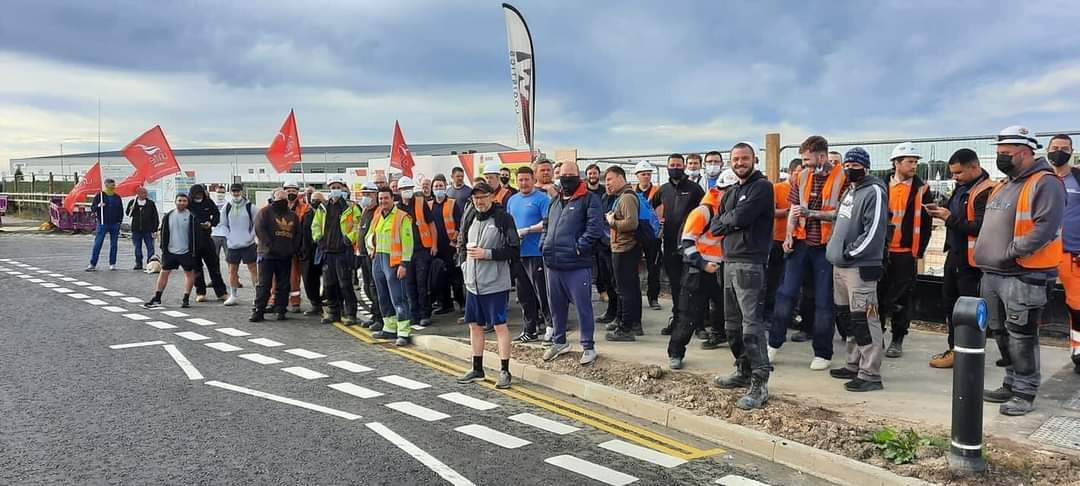
Tyrone O’Sullivan: Towering Welsh Miner & Fighter For The Working Class
On the evening of 28 May Tyrone O’Sullivan of Tower Colliery died peacefully at home, in his garden, aged 77. Here Brian Parkin pays tribute to a friend and comrade, who through a combination of fire and gentle persuasion, led a community of mining families into a fight to save the last deep coal mine in South Wales. This article was originally published on RS21
By Brian Parkin. Cover Image: Tyrone O’Sullivan prepares to address a rally for Jeremy Corbyn in Merthyr Tydfil, 2016. Via Kevin Glennie on Facebook
During the epic miners’ strike of 1984-85 an unassuming man came all the way up from a solid South Wales to assure Yorkshire miners of South Wales’s determination to fight on. The South Wales NUM had allowed Kim Howells, an unelected Eurocommunist research officer, to be their spokesperson, and Howells used every opportunity to attack the strike and give the impression that the South Wales miners were flagging. Now at a rally at Kellingley colliery, a gentle speaking and mild-mannered Welsh miner gave the most eloquent and militant contribution that I had heard up to that point in the strike. His name was Tyrone O’Sullivan and the community of Kellingley cheered him to the rafters.
Fast forward to 1988, and (perhaps ironically, as an unelected research officer for the national NUM) I had the chance to meet Tyrone in person. The first time was at the union’s delegate conference, to which each pit sent four delegates. Post-strike the mood of the union was in part tetchy and parochial. George Bolton, secretary of the Scottish NUM argued that rather than rely on a national response to pit closures, area (regions) of the union would be better going it alone. In response Tyrone said, quoting directly Angela Davis: ‘George, if you turn your back on a small struggling Durham pit, how will it make you any safer – because if they come for me in the night, they will come for you in the morning’.
Tyrone and Tower colliery
Tyrone was born in Abercwmboi, a small mining township, near Hirwaun in the Cynon valley, situated between the great mining valleys of the Rhondda and Merthyr. From a mining family, he followed his father and brothers into the coal industry at the age of fifteen – to Tower colliery, where his father was later killed in a pit accident. Well-read, and with an acutely political mind, he became a pit delegate at Tower colliery, and was soon able to read the minds of the more bureaucratic elements of the South Wales NUM. This, plus a deep-seated sense of rank and file solidarity, made for a passionate socialist. A life-long Labour Party member, he was a Militant supporter before and during the strike, and for a while after, and always ready to work with anyone on the left who wanted to fight.
And it was largely under Tyrone’s leadership that Tower gained the reputation as the most militant pit in South Wales, at times striking in support with struggling nurses, as well as dockers in the port of Barry.
Initially, Tower and six other South Wales collieries came out of the ’84-’85 strike more or less unscathed. But with a Tory government determined to finish off the UK coal industry entirely, a gradual attrition due to lack of investment, plus precarious coal contracts made even more so with electricity privatisation, it did not take long before the coup de grâce was delivered.
The pit closure crisis
On the first Thursday of October 1992, I was sitting at the back of what seemed like a routine NUM Executive meeting when our Research Department secretary brought through an item of the morning mail. She had opened what appeared to be an unstamped and therefore hand-delivered large envelope, and had immediately realised its importance. It was a copy of a highly confidential report to the Secretary of State to the Department of Trade and Industry. It was a detailed and immediate closure programme for 31 collieries. And clearly marked for closure were the last three pits in South Wales.
Amid mass demonstrations and lobbies of parliament, we plunged into the Modified Colliery Review Procedure. We went to colliery communities to assess the viability of pits as well as make the case for the local communities and their future. But to no avail. One pit that I visited, Taff Merthyr, was literally at the end of the valley, and as one woman I met said: ‘If this pit goes, our valley will die’. And it did.
Furthermore, the mass closure programme was to be followed up quickly by a Coal Industry Act which would truss and stuff what remained of the coal industry for privatisation. But unable to deliver industrial action, and totally opposed to any private ownership of the pits, the NUM leadership haughtily refused to advise its membership regarding survival post-privatisation, thus declaring the most militant and glorious trade union in British labour movement history irrelevant.
Tower has the power
Right from the start, Tyrone was determined to save Tower colliery. As soon as British Coal announced the closure, the local community was mobilised into a campaign. Top rock bands Bronski Beat and Manic Street Preachers devoted revenues from their record sales to the Tower campaign. Just before Christmas 1994 Ann Clywd, the local MP, went underground at the mine with pit deputy Glyn Roberts. This stopped the drainage pumps and the ventilation fans being turned off. It was then that Tyrone contacted me with his plans for the pit. On the basis of extensive coal reserves data, and the output capacity of the pit’s face machinery, Tower was easily capable of producing of over one million tonnes of premium coal per year. ‘So how can I help Tyrone?’ I asked. ‘Well, we need a fucking market, for starters’, he replied.
At a meeting of nearly 300 miners in the welfare hall, a workers’ buy-out was proposed. With all his eloquence and passion and clear commitment to honesty and democracy, Tyrone asked each miner to invest £8,000 from their £42,000 redundancy pay into an NUM Goitre Tower Anthracite Colliery – a pit owned by the miners and for them and their community. They agreed unanimously. Then Tyrone called me: ‘Now boyo, get us that market’.
One week later I was able to arrange a meeting with the management at Aberthaw power station. And within an hour of me reminding them of the global scarcity of the low volatile coal they required, and the availability of it only twenty miles away from Tower colliery, a ten-year extension to the existing contract for one million tonnes per year was agreed. Then, as if to rub the noses of their detractors in the dirt, the miners at Tower turned in a profit of £11 million in just three years.
Black diamonds
The last time that I saw Tyrone and Tower colliery was when I went down the pit to celebrate the installation of a brand-new face. It was in the ‘Small Yard’ seam; a seam that was in fact over two meters thick. I asked how long the present planned extraction would last – to which Tyrone answered about ten years. ‘That’s about right’, I said, ‘because by then, global warming will be ringing the end for coal-fired power generation’. ‘So just in time’, he grinned. (After 13 years of safe and democratic ownership, Tower closed amid a tearful celebration on 27 January 2008.)
Then, crawling along the coal-face prior to the shift starting up, we stopped. ‘Now look’, he said, shining his lamp along the glittering face, ‘Nothing like it outside South Wales: black diamonds’. And he was right. Like no other coalface I had seen, the coal reflected in the lamplight like diamonds. But tragically, this was the cause of Tyrone’s and other Tower men’s condition: a wheezing breath and rumbling cough. Silicosis; a life-shortening condition caused by the dust from rock-hard anthracite and its deadly silicon trace element, was the condition that Tyrone suffered with to his end a few weeks ago.
Pride….and prouder
But it was in the great strike of 1984-85 where he best showed an instinctive and passionate seam of leadership and solidarity. Halfway through the strike, a small LBGT collective in London, with some trepidation, decided to demonstrate their practical solidarity with the striking miners of South Wales. Fearing rejection or worse, they nevertheless drove in a battered campervan with food, money and other supplies into the Welsh valleys. A wonderful account of this coming together can be seen in the film Pride. This proved to be a crucial point in the strike, in that it unleashed a torrent of talent from the women of the valleys, who emerged from the sidelines of the strike, and onto front of stage by speaking and calling for solidarity from LGBT people at venues across London.
And Tyrone had always said of strikes, ‘It’s a wonderful feeling that a strike gives you. Because, win or lose, you have given your all, and tasted solidarity. You have fought the fight!’ And of the LGBT solidarity? ‘Well, they came to us as friends, and we let them in. And that in many ways, allowed us to come out. Bloody marvellous!’


